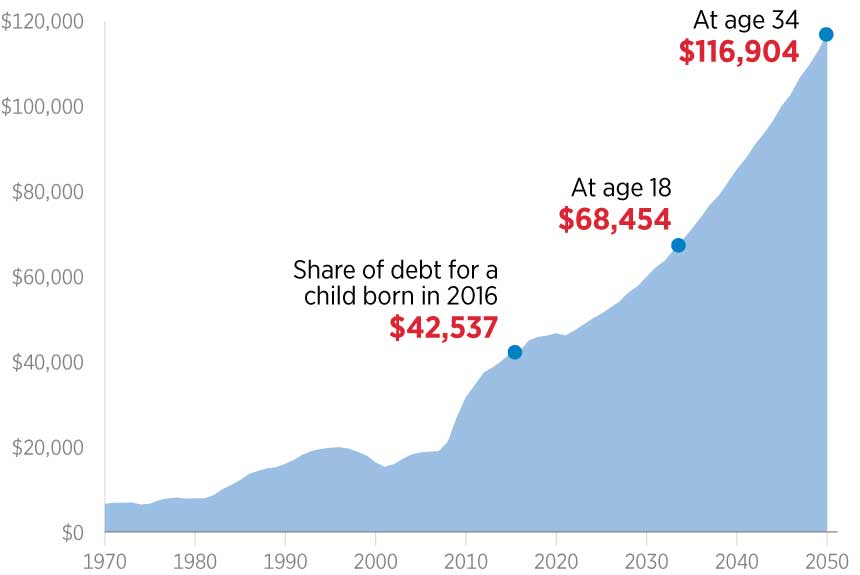The One Percent Spending Reduction Act
It's simple. It's fair. It forces action.
The American economist Herb Stein once observed that “If something cannot go on forever, it will stop.”
I don’t know when the stop will come, but I know that we are rapidly approaching a financial day of reckoning with regard to federal spending. And if Washington doesn’t act before financial markets do to stem the tide of spending, there will be horrific consequences for everyone of us - in the value of the currency we hold, in inflation, in the worth of our savings, and in our way of life. Each day, we take one more step toward a day of financial Armageddon, yet we are sleepwalking our way there in Washington.
Today, it’s estimated that our country’s liabilities are greater than our assets and that we have roughly $120 trillion in unpaid political promises. It’s shown that our federal debt is $19.3 trillion - $9 trillion more than it was 8 years ago. The Congressional Budget Office predicts that ten years from now, the federal debt will have grown by another $10 trillion. More significantly, the federal debt-to-GDP ratio is expected to grow from its current level - 75 percent - to almost double that over the next 20 to 25 years. This would put our country at Greece’s debt level at the time its crisis began a few years back - but without a big (financial) brother like the European Union to save us, as was their case.
Interest on the Debt to Triple

Because of the growing federal debt, interest costs for the federal government are projected to more than triple over the next ten years from $255 billion this year to a projected $830 billion in 2026. As a reference point, that is greater than what we currently spend on national defense.
Quite simply, we are on Herb Stein’s course that indeed cannot go on forever, and the question is what are we going to do about it?
The key will be removing at least some of the politics that make doing so seemingly impossible.
Accordingly, one option for fixing the problem lies in a bill Senator Mike Enzi and I just introduced called the One Percent Spending Reduction Act of 2016. It’s also known as the Penny Plan because it proposes to cut just one penny of every dollar in federal spending. Do that for the next five years, and we would have a balanced budget. In the sixth year, spending would be capped at 18 percent of Gross Domestic Product, preventing further overspending while allowing the budget to grow in step with the economy.
Finding ways to trim back is what families do around the kitchen counter. Businesses do it too. The question we have to ask is whether or not we believe cutting a penny a year for the next five years is too big a lift for Congress to avoid spiraling debt and spending problems that I believe will be the consequence of doing nothing.
The Penny Plan has several attributes.
It’s simple, which is the opposite of how the debt and spending problems are discussed in Washington. Rather than talking about billions, trillions, the “baseline,” concurrent resolution, appropriations and more, why not talk about a penny a year?
It’s fair. Quite logically, people are not for spending less when they will bear its brunt, while others are spared. The only way to limit spending in Congress is for everyone to climb into the boat together. Until that happens, I don’t believe we will see spending limited, and the law of the jungle will reign supreme with everyone trying to cut from other people’s constituencies rather than their own. In fact, it was former Senate Majority Leader Everett Dirksen who used to say, “don’t tax you, don’t tax me, tax that fellow behind the tree.”
Finally, the bill forces action. All political bodies wait to respond. They wait until there is a burning platform. When it's burning, you have to act; until it is, you don’t. By offering across-the-board cuts if nothing is done, the bill could kick-start Congress into taking some action on programs that are no longer needed. Congress has the option of cutting some programs more aggressively while protecting others that are more useful...so long as the total spending reduction adds up to one percent of the budget.
I could walk through other attributes, but in building a plan to limit our federal government’s rampant spending, simplicity, fairness, and a bias to force action seem like good places to start.
"The most significant threat to our national security is our debt."
- Admiral Mike Mullin
National Debt for Every American






